stop start Citroen C3 2015 2.G Owner's Guide
[x] Cancel search | Manufacturer: CITROEN, Model Year: 2015, Model line: C3, Model: Citroen C3 2015 2.GPages: 401, PDF Size: 13.04 MB
Page 146 of 401

144
bonnet
Opening
F Push the exterior safety catch B to the left and raise the bonnet. F
U
nclip the bonnet stay C from its housing,
holding it by its foam protection.
F
F
ix the stay in the notch to hold the bonnet
open. F
T
ake the stay out of the support notch.
F
C
lip the stay in its housing.
F
L
ower the bonnet and release it at the end
of its travel.
F
P
ull on the bonnet to check that it is fully
latched.
F o
p
en the front left door.
F
P
ull the interior release lever A
, located at
the bottom of the door aperture.
The location of the interior release lever
prevents opening of the bonnet while
the front left door is closed.
When the engine is hot, handle the
exterior safety catch and the stay with
care.
be
fore doing anything under the
bonnet, switch off the Stop & Start
system to avoid any risk of injury
resulting from an automatic change to
S T a
R
T m o d e .
Closing
To avoid damaging the electric units,
the use of a high pressure jet wash
under the bonnet is strictly prohibited.
Checks
Page 152 of 401

150
according to your version of instrument panel, the
start of saturation of the particle filter is indicated by:
- fixed illumination of the particle filter warning lamp, accompanied
by an audible signal,
or
-
t
emporary illumination of
the service warning lamp,
accompanied by an audible signal
and a message that there is a risk
of blockage of the particle filter.
as s
oon as the traffic conditions permit, regenerate
the filter by driving at a speed of at least 40
mph
(60
km/h) until the warning lamp goes off.
If the warning lamp stays on, refer to the "Additive
level" section.
Checks
12 V battery
The battery does not require any maintenance.
However, check that the terminals are clean
and correctly tightened, particularly in summer
and winter.
The presence of this label, in particular with
the Stop & Start system, indicates the use of
a specific 12
V lead-acid battery with special
technology and specification. The involvement
of a CITROËN dealer or a qualified workshop
is essential when replacing or disconnecting
the battery. When carrying out work on the battery, refer
to the "12 V battery" section for details of the
precautions to be taken before disconnecting
the battery and following its reconnection. Unless other wise indicated, check these components in accordance with the manufacturer's
service schedule and according to your engine.
Other wise, have them checked by a CITROËN dealer or a qualified workshop.
On a new vehicle, the first operations of
regeneration of the particle filter may be
accompanied by the smell of "burning",
which is per fectly normal.
Following prolonged operation of the
vehicle at very low speed or at idle,
you may, in exceptional circumstances,
notice the emission of water vapour at
the exhaust on acceleration. This does
not affect the behaviour of the vehicle
or the environment.
Particle filter (Diesel)
Air filter and passenger compartment filter
Refer to the manufacturer's
service schedule for details of the
replacement intervals for these
components.
Depending on the environment (e.g. dusty
atmosphere) and the use of the vehicle
(e.g.
city driving), replace them twice as often
if necessary .
a c
logged passenger compartment filter may
have an adverse effect on the per formance
of the air conditioning system and generate
undesirable odours.
Replace the oil filter each time the
engine oil is changed.
Refer to the manufacturer's
service schedule for details of
the replacement interval for this
component.
Oil filter
Checks
Page 154 of 401
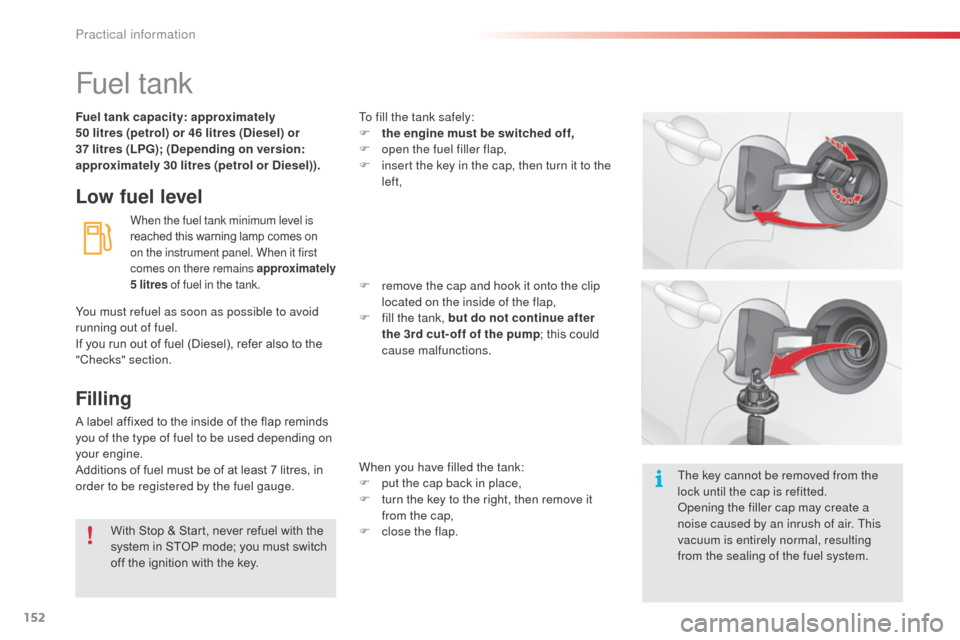
152
Fuel tank
Low fuel level
When the fuel tank minimum level is
reached this warning lamp comes on
on the instrument panel. When it first
comes on there remains approximately
5 litres of fuel in the tank.
Filling
A label affixed to the inside of the flap reminds
you of the type of fuel to be used depending on
your engine.
Additions of fuel must be of at least 7 litres, in
order to be registered by the fuel gauge.To fill the tank safely:
F
t
he engine must be switched off,
F
o
pen the fuel filler flap,
F
i
nsert the key in the cap, then turn it to the
left,
F
r
emove the cap and hook it onto the clip
located on the inside of the flap,
F
f
ill the tank, but do not continue after
the 3rd cut- off of the pump
; this could
cause malfunctions.
When you have filled the tank:
F
p
ut the cap back in place,
F
t
urn the key to the right, then remove it
from the cap,
F
c
lose the flap.
You must refuel as soon as possible to avoid
running out of fuel.
If you run out of fuel (Diesel), refer also to the
"Checks" section. Fuel tank capacity: approximately
50 litres (petrol) or 46 litres (Diesel) or
37 litres (LPG); (Depending on version:
approximately 30 litres (petrol or Diesel)).
With Stop & Start, never refuel with the
system in STOP mode; you must switch
off the ignition with the key. The key cannot be removed from the
lock until the cap is refitted.
op
ening the filler cap may create a
noise caused by an inrush of air. This
vacuum is entirely normal, resulting
from the sealing of the fuel system.
Practical information
Page 167 of 401
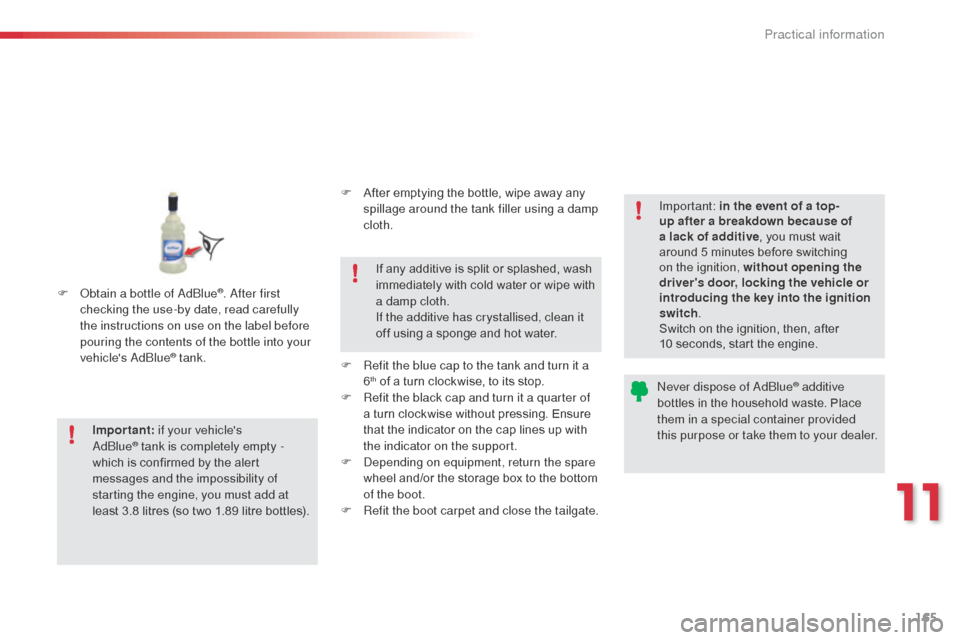
165
F obtain a bottle of adbl ue®. after first
checking the use-by date, read carefully
the instructions on use on the label before
pouring the contents of the bottle into your
vehicle's
a
d
blu
e
® tank.
Important : if your vehicle's
a
d
blu
e
® tank is completely empty -
w
hich is confirmed by the alert
messages and the impossibility of
starting the engine, you must add at
least 3.8 litres (so two 1.89 litre bottles). If any additive is split or splashed, wash
immediately with cold water or wipe with
a damp cloth.
If the additive has crystallised, clean it
off using a sponge and hot water.
Important: in the event of a top-
up after a breakdown because of
a lack of additive
, you must wait
around 5 minutes before switching
on the ignition, without opening the
driver's door, locking the vehicle or
introducing the key into the ignition
switch .
Switch on the ignition, then, after
10 seconds, start the engine.
ne
ver dispose of a
dbl
ue
® additive
bottles in the household waste. Place
them in a special container provided
this purpose or take them to your dealer.
F
A
fter emptying the bottle, wipe away any
spillage around the tank filler using a damp
cloth.
F
R
efit the blue cap to the tank and turn it a
6th of a turn clockwise, to its stop.
F
R
efit the black cap and turn it a quarter of
a turn clockwise without pressing. Ensure
that the indicator on the cap lines up with
the indicator on the support.
F
d
e
pending on equipment, return the spare
wheel and/or the storage box to the bottom
of the boot.
F
R
efit the boot carpet and close the tailgate.
11
Practical information
Page 195 of 401

193
battery
Access to the battery
The battery is located under the bonnet.
To gain access to it:
F
o
pen the bonnet using the interior release
lever, then the exterior safety catch,
F
s
ecure the bonnet stay,
F
l
ift the plastic cover on the (+) terminal.
The presence of this label, in particular
with the Stop & Start system, indicates
the use of a 12 V lead-acid battery with
special technology and specification;
the involvement of a CITR
oËn
dealer
or a qualified workshop is essential
when replacing or disconnecting the
battery.
Failure to observe this recommendation
may cause premature wear of the
battery.
af
ter refitting the battery by a CITR
oËn
dealer or a qualified workshop,
the Stop
& Start system will only
be active after a continuous period
of immobilisation of the vehicle, a
period which depends on the climatic
conditions and the state of charge of
the battery (up to about 8
hours).
Procedure for charging your battery when it is flat or for starting the engine using another battery.
11
Practical information
Page 198 of 401
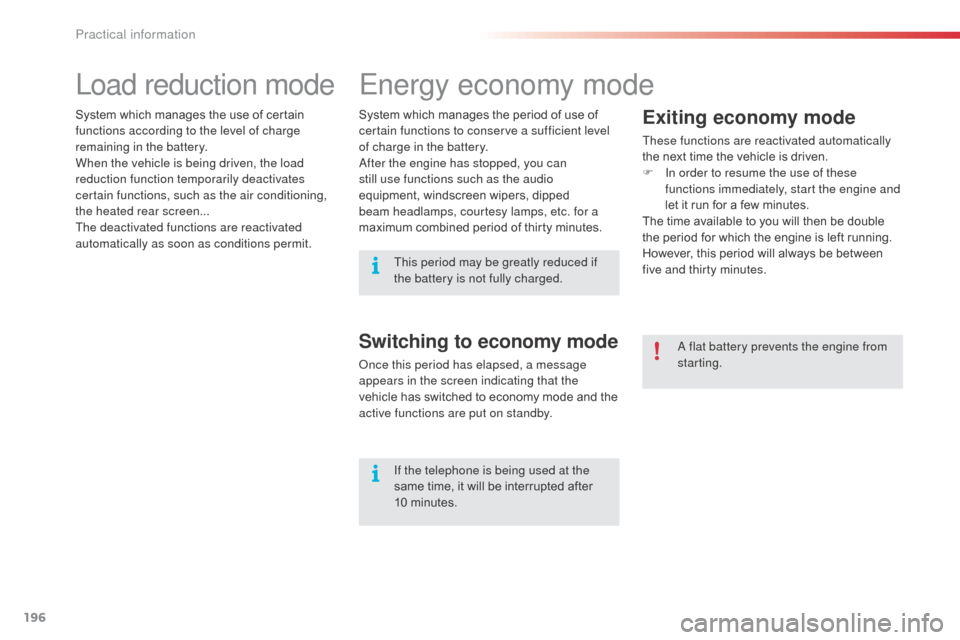
196
Energy economy mode
Exiting economy mode
These functions are reactivated automatically
the next time the vehicle is driven.
F
I
n order to resume the use of these
functions immediately, start the engine and
let it run for a few minutes.
The time available to you will then be double
the period for which the engine is left running.
However, this period will always be between
five and thirty minutes.
Switching to economy mode
once this period has elapsed, a message
appears in the screen indicating that the
vehicle has switched to economy mode and the
active functions are put on standby.
a
flat battery prevents the engine from
starting.
If the telephone is being used at the
same time, it will be interrupted after
10 minutes.
System which manages the period of use of
certain functions to conserve a sufficient level
of charge in the battery.
af
ter the engine has stopped, you can
still use functions such as the audio
equipment, windscreen wipers, dipped
beam headlamps, courtesy lamps, etc. for a
maximum combined period of thirty minutes.
System which manages the use of certain
functions according to the level of charge
remaining in the battery.
When the vehicle is being driven, the load
reduction function temporarily deactivates
certain functions, such as the air conditioning,
the heated rear screen...
The deactivated functions are reactivated
automatically as soon as conditions permit.
Load reduction mode
This period may be greatly reduced if
the battery is not fully charged.
Practical information
Page 204 of 401
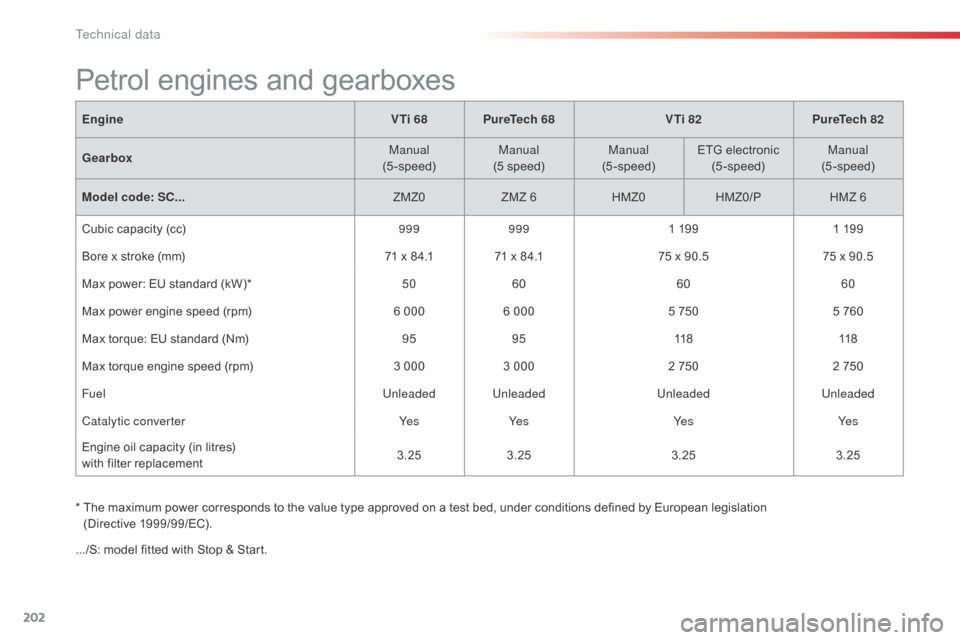
202
EngineVTi 68PureTech 68 VTi 82PureTech 82
Gearbox Manual
(5-speed) Manual
(5 speed) Manual
(5-speed) ETG electronic
(5-speed) Manual
(5-speed)
Model code: SC... ZMZ0ZMZ 6 HMZ0HMZ0/P HMZ 6
Cubic capacity (cc) 999999 1 199 1 199
Bore x stroke (mm) 71 x 84.171 x 84.1 75 x 90.5 75 x 90.5
Max power: EU standard (kW)* 5060 6060
Max power engine speed (rpm) 6 0006 000 5 7505 760
Max torque: EU standard (Nm) 9595 118 118
Max torque engine speed (rpm) 3 0003 000 2 7502 750
Fuel Unleaded UnleadedUnleadedUnleaded
Catalytic converter Ye sYe s Ye sYe s
Engine oil capacity (in litres)
with filter replacement 3.25
3.25 3.253.25
Petrol engines and gearboxes
* The maximum power corresponds to the value type approved on a test bed, under conditions defined by European legislation
(Directive 1999/99/EC).
.../S: model fitted with Stop & Start.
Technical data
Page 205 of 401
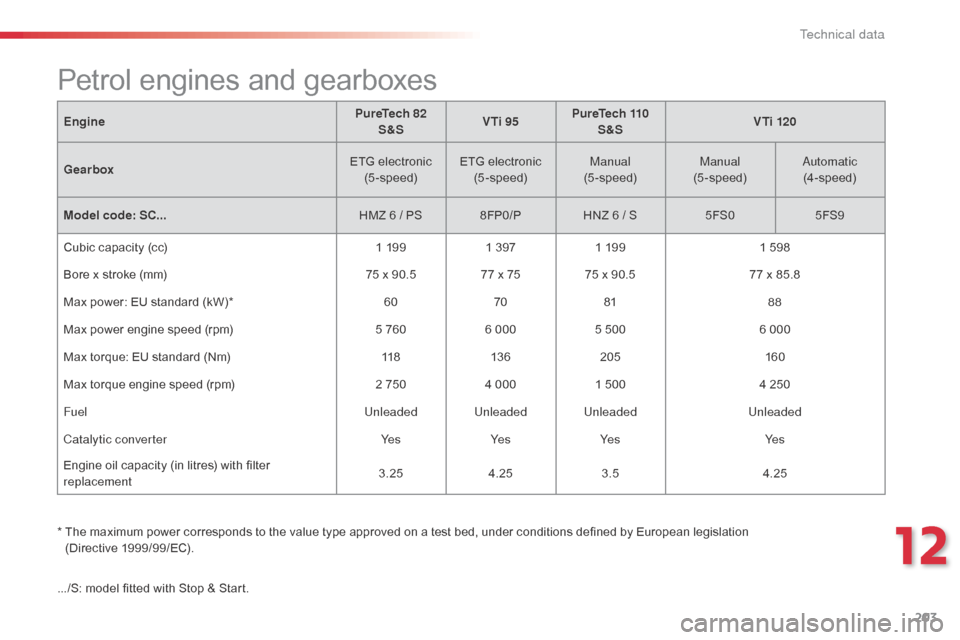
203
* The maximum power corresponds to the value type approved on a test bed, under conditions defined by European legislation (Directive 1999/99/EC).
Petrol engines and gearboxes
Engine PureTech 82
S&S VTi 95PureTech 110
S&S V Ti 120
Gearbox ETG electronic
(5-speed) ETG electronic
(5-speed) Manual
(5-speed) Manual
(5-speed)
a
utomatic
(4-speed)
Model code: SC... HMZ 6 / PS8FP0/PHNZ 6 / S 5FS05FS9
Cubic capacity (cc) 1 1991 397 1 199 1 598
Bore x stroke (mm) 75 x 90.577 x 7575 x 90.5 77 x 85.8
Max power: EU standard (kW)* 607081 88
Max power engine speed (rpm) 5 7606 000 5 500 6 000
Max torque: EU standard (Nm) 11813 6 205 160
Max torque engine speed (rpm) 2 7504 000 1 500 4 250
Fuel Unleaded Unleaded Unleaded Unleaded
Catalytic converter Ye sYe sYe s Ye s
Engine oil capacity (in litres) with filter
replacement 3.25
4.25 3.5 4.25
.../S: model fitted with Stop & Start.
12
Technical data
Page 210 of 401

208
* The maximum power corresponds to the value type approved on a test bed, under conditions defined by European legislation (Directive 1999/99/EC).
Diesel engines and gearboxes
Engine HDi 70 FAP e- HDi 70 FAPHDi 75 BlueHDi 75 HDi 90
Gearbox Manual
(5-speed) ETG electronic
(5-speed) Manual
(5-speed) Manual
(5-speed) Manual
(5-speed)
Model code: SC... 8HR48HP4/PS 9HK0BHW 6 9HJ0
Cubic capacity (cc) 1 3981 3981 560 1 5601 560
Bore x stroke (mm) 73.7 x 82 73.7 x 82 75 x 88.3 75 x 88.3 75 x 88.3
Max. power: EU standard (kW)* 5050555568
Max. power engine speed (rpm) 4 0004 0004 000 3 5004 000
Max. torque: EU standard (Nm) 160160 185233 230
Max. torque engine speed (rpm) 1 7501 7501 500 1 7501 750
Fuel
die
sel
die
sel
die
sel
die
sel
die
sel
Catalytic converter Ye sYe sYe sYe sYe s
Particle filter (FAP) Ye sYe s
n
oYe s
n
o
Engine oil capacity (in litres)
with filter replacement 3.75
3.753.753.753.75
.../S: e-HDi model fitted with Stop & Start.
Technical data
Page 211 of 401
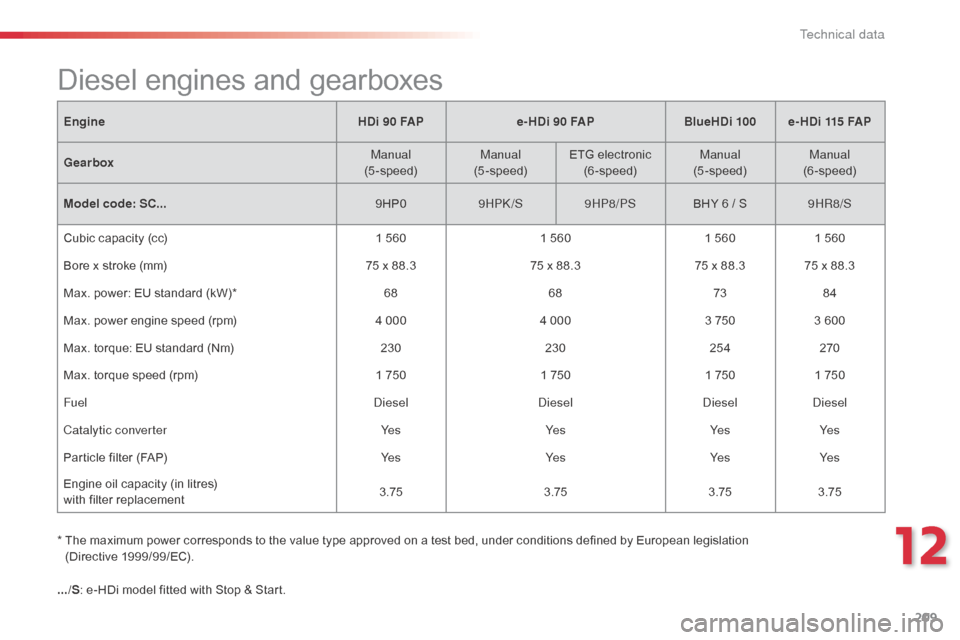
209
.../S: e-HDi model fitted with Stop & Start.
*
T
he maximum power corresponds to the value type approved on a test bed, under conditions defined by European legislation
(Directive 1999/99/EC).
Engine
HDi 90 FAPe- HDi 90 FAP BlueHDi 100e- HDi 115 FAP
Gearbox Manual
(5-speed) Manual
(5-speed) ETG electronic
(6-speed) Manual
(5-speed) Manual
(6-speed)
Model code: SC... 9HP09HP k
/
S
9HP8/PS BHY 6 / S 9HR8/S
Cubic capacity (cc) 1 5601 5601 5601 560
Bore x stroke (mm) 75 x 88.375 x 88.375 x 88.3 75 x 88.3
Max. power: EU standard (kW)* 6868 7384
Max. power engine speed (rpm) 4 0004 000 3 7503 600
Max. torque: EU standard (Nm) 230230254270
Max. torque speed (rpm) 1 7501 7501 7501 750
Fuel
die
sel
die
sel
die
sel
die
sel
Catalytic converter Ye sYe sYe sYe s
Particle filter (FAP) Ye sYe sYe sYe s
Engine oil capacity (in litres)
with filter replacement 3.75
3.753.753.75
Diesel engines and gearboxes
12
Technical data